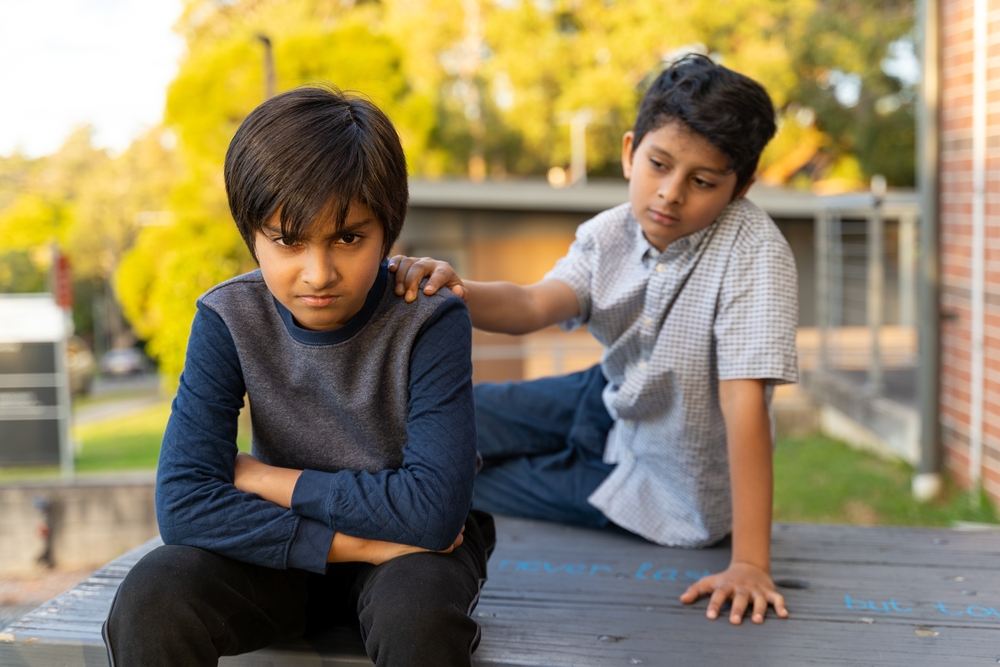
The Magic of the Buddy Bench
Written by Ruti Eastman
You don’t have to be an adult to make a difference, you can be a kid too! It’s good to be kind.~ Sammie Vance
“Maya, you have agreed to wear the Designated Buddy vest this week. That means that if a kid on the playground feels lonely and wants someone to talk to, you agree to be his or her buddy for a few minutes. Some kids will be brave enough to sit on the Buddy Bench, so you should keep your eyes out for them. Are you ready to do this very important job?”
The eight-year-old nodded solemnly and donned her vest. She had been selected because she was one of the kids other kids flocked to, because she got along easily with all kinds of kids and had the respect of the group. During her week of “duty,” she gained confidence in her ability not only to comfort lonely kids, but to calm fights before they got out of hand. She even stood toe to toe with a bully at one point until a teacher came to deal with the issue. More than one kid expressed gratitude to her for being there.
Finding the originator of the Buddy Bench or Friendship Bench proved to be much more difficult than expected. Since the need for such a concept is universal, it is not so surprising that many people have “invented” it.
In 2018, Sammie Vance, the founder of the Buddy Bench in her Indiana town, published a children’s book about her journey to make a difference.
“When I was in third grade, I decided to do the buddy bench project for my school,” Vance said. “I realized there are so many people who are lonely, and I’ve been lonely myself. It’s not a good feeling.”
In 2016, Dr. Dixon Chibanda came up with the idea of a friendship bench to help in the treatment of depression for the people of Zimbabwe, as mental health treatment was inaccessible. He trained 14 grandmothers as mental health counselors for a pilot project.
In 2013, a first grader named Christian Buck was struggling with what it would be like to be the new kid at school, as his dad’s job could mean a move to Germany. Christian and his mom discovered that one of the schools he might attend included a special bench in their playground for children who were feeling lonely during recess.
Other kids have been instrumental in spreading this idea around the United States and the world. In 2012, a fifth grader named Acacia “Tiny” Woodley introduced the idea of the Friendship Bench at her new school in Florida after she experienced bullying. After successfully getting the bench installed at her school, she started her own company called Tiny Girl, Big Dream, and began to speak publicly about her ideas to lessen the misery of kids at school.
The inspiring aspect of all these stories is that they were started by a person — often a child — who saw a need to end another human being’s pain and isolation. None of these creative people waited for someone else to come up with solutions, and none of them ignored bullying or loneliness, thinking it to be someone else’s responsibility.
Teaching our children never to bully others is the first step. We need to impress upon them that “dos passt dir nisht,” as our grandmothers used to say: that such behavior is beneath them. And the next, higher step is to embolden good young people to reach out and be the buddy for a lonely kid on the playground, with or without a Designated Buddy vest. We can model this exemplary behavior by allowing our children to see that we try to be available to adults who need someone to talk to, or just a kind word.
As she turned in her vest after her week as a designated buddy, Maya looked forward to her next opportunity. Even when it wasn’t her turn, Maya found herself, in ensuing weeks, looking to see if anyone was sitting on the Buddy Bench, waiting for a friendly conversation. Little did Maya realize that she had learned more life skills in that week than she would in lectures on the subject of kindness over the next few years.
Bullying will probably never go away. Nor will loneliness. The worst thing teachers and communities and nice, popular kids can do is to ignore the problem. Perhaps one of the best things they can all do is to establish opportunities and spaces for kids without a friend to feel they have a listening ear.

The inspiring aspect of all these stories is that they were started by a person — often a child — who saw a need to end another human being’s pain and isolation.
Related Articles
Related
Evaluating Single-Sex and Co-Ed Schools
Winter is ending and spring is beginning; the time for choosing a Jewish day school is near and one of the biggest questions that parents and students face is whether to enroll in a single-sex or a co-ed school. Boys’ schools, girls’ schools, and co-ed schools have...
Kumzitz and Laugh
In the darkest recesses of the human mind, in a place so heavy with shadow it seems impossible for a pinprick of light to shine through, a spark exists. That tiny ray seems like a direction, a point of promise, a simple moment of relief from the reality of the world...
Kids & Technology
The scene is familiar. You try speaking to your kid and hear a grunt in response, you turn around and you see that they are totally engrossed in their device. You call them again, again you hear a grunt. Finally you get super close to them and say, “It’s time to...
